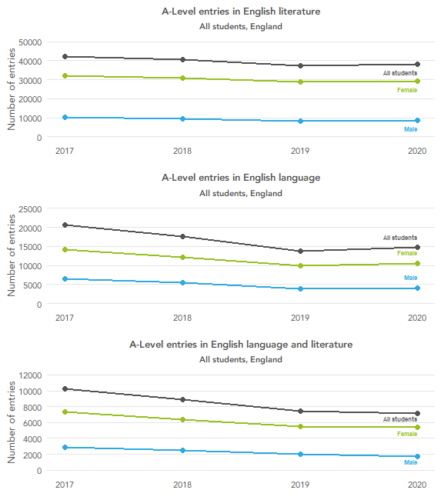Students will receive their A-level results tomorrow.
In this blogpost, we look ahead to what the results might show.
1. Increased entry numbers for some subjects including STEM and the social sciences
The numbers studying geography and law are expected to receive the biggest boost. Both are set to increase by well over 10% from 2020, based on preliminary data released by Ofqual in May.
We should note, though, that entries to geography have been historically volatile. The increase this year follows a fall of 14% last year.

Entry numbers in biology, chemistry and physics are all expected to increase slightly this year. But, once again, we’re expecting a particularly large rise in numbers studying computing. These are set to increase by 10%, and this follows an increase of 11% last year.
We’re also expecting the social sciences to fare well, with entries in economics up by 6%, and in both psychology and sociology by 8%. Psychology is now the second most popular A-Level subject after maths, and sociology is on track to break into the top five next year.
2. Entries to English are likely to fall again
We’ve posted before about the decline in A-Level English entries (link).
They’ve been falling for a number of years, but in 2020 had a slight reprieve, with increases of 2% in English literature entries and 7% in English language.

But in 2021 we’re expecting another fall, especially in English literature where entries are expected to be down by 6%.
3. Slightly higher grades than last year (probably)
As we all know by now, grades this year will be based on teacher assessment as public exams did not take place. Teachers have been asked to base their grades on work that students have completed. This is a different approach to last year, when schools were asked to grade students based on what they would have expected them to achieve had exams taken place.
We might expect this year’s results to be a bit higher than last year. But we don’t know, what, if any, effect the external quality assurance undertaken by exam boards will have had.
We’re also expecting that female students will be more likely to achieve the top grades than male students once again this year.

From 2017-19, male students were slightly more likely than female students to achieve an A or A*, but this reversed in 2020 with the cancellation of exams. We expect that this will continue in 2021 but revert back to the pre-pandemic pattern when exams do return.
4. What we won’t learn
We’re not expecting detailed analysis on entry numbers and grades by student characteristics – disadvantage and ethnicity, for example – to be published straight away. We expect Ofqual will release a high level equalities impact assessment but it will only be later in the year that a more detailed analysis will be available.
The analysis of last year’s results that DfE has published showed that, compared to 2019, disadvantaged students’ grades increased slightly more than their peers’. The effect of this was to narrow the gap between disadvantaged students and their peers by around a twentieth of a grade.
If the teacher-assessed grades awarded this year follow similar patterns to last year’s centre-assessed grades, there will be another small reduction in the attainment gap in 2021.
On the other hand, we do know that disadvantaged pupils have missed more school than their peers, at least up until the end of Key Stage 4. Students who have missed out on teaching – and potentially on taking the assessments with which teachers will be assessing their performance – might well end up with lower grades.
So we might expect the attainment gap between disadvantaged students and their peers to widen this year. But we’re unlikely to get any answers about that on Tuesday.
5. Don’t forget about other level 3 qualifications
We probably won’t hear very much about qualifications other than A-Levels. The focus on Tuesday will be on the A-Level results published by JCQ. But there are a very substantial number of entries to other Level 3 qualifications, especially applied general courses (such as BTECs and Cambridge Technicals).
In fact, as we’ve noted in the past, entries are far higher than reported in Key Stage 5 performance tables. There were just over 180 thousand entries to applied general qualifications in 2019, not all that far behind the 260 thousand entries to A-Level.
Students taking these qualifications are far more likely to be disadvantaged than those taking A-Levels – in 2019 24% were disadvantaged students who completed Key Stage 4 in state schools, compared to 13% of A-Level students.
In fact, the group of students who took A-levels having completed Key Stage 4 in independent schools was larger in size than the group of students who were disadvantaged and who completed Key Stage 4 in state schools.
They’re a group that we shouldn’t ignore, and many of those taking Level 3 BTECs will also be getting their results on Tuesday. But Pearson – the exam board that runs BTECs – don’t tend to publically release data and analysis on results day as JCQ does for A-Levels.
Last year, Ofqual did release some analysis of results from vocational and technical qualifications. They may do so again this year. But there’s a chance that we’ll have to wait to learn about national trends in Level 3 qualifications other than A-Levels.
We’ll be publishing analysis of this year’s A-Level results on Tuesday morning. Sign up to our mailing list to be notified about these blogposts, or check back here on the day.
In the meantime, take a look at our microsite, which allows you to explore trends in A-Level and AS-Level entries and attainment yourself.






Leave A Comment